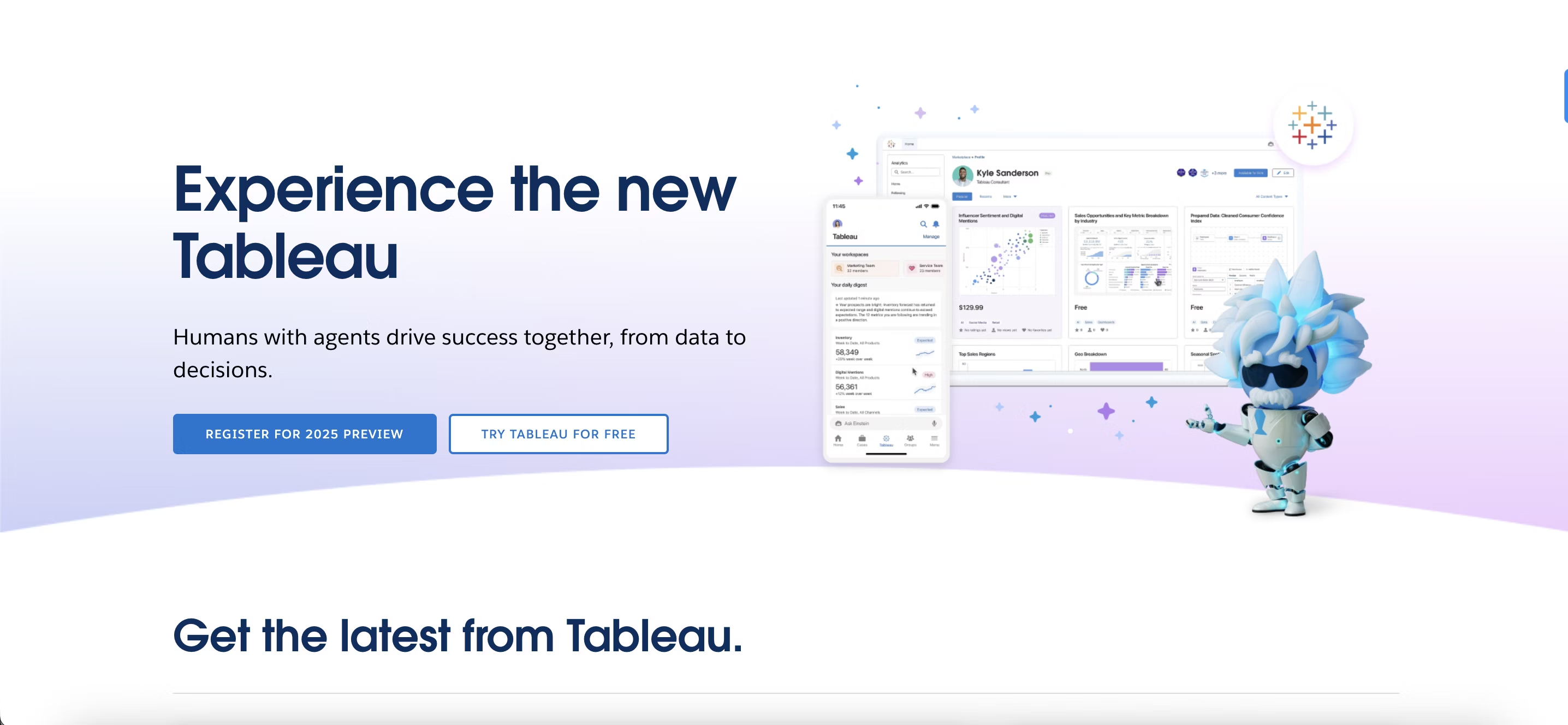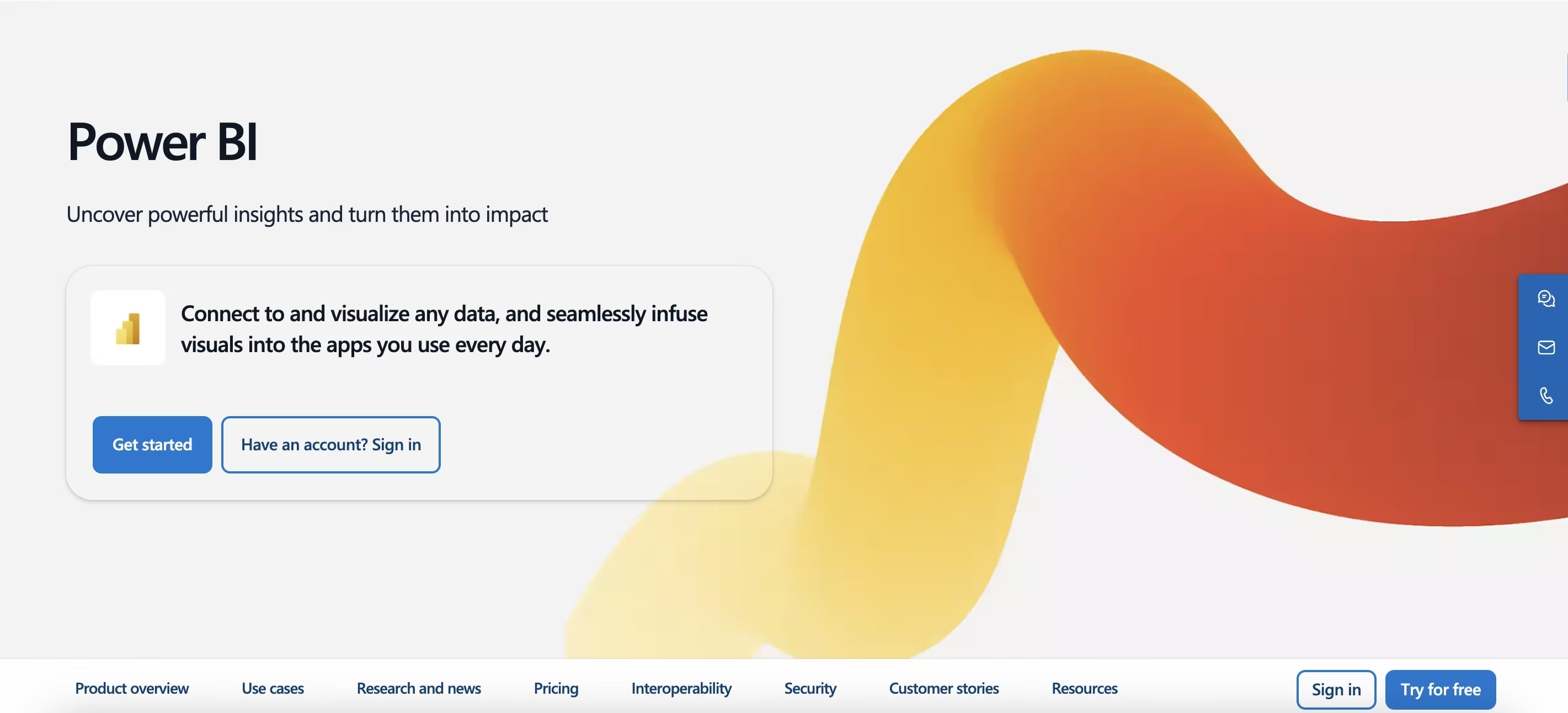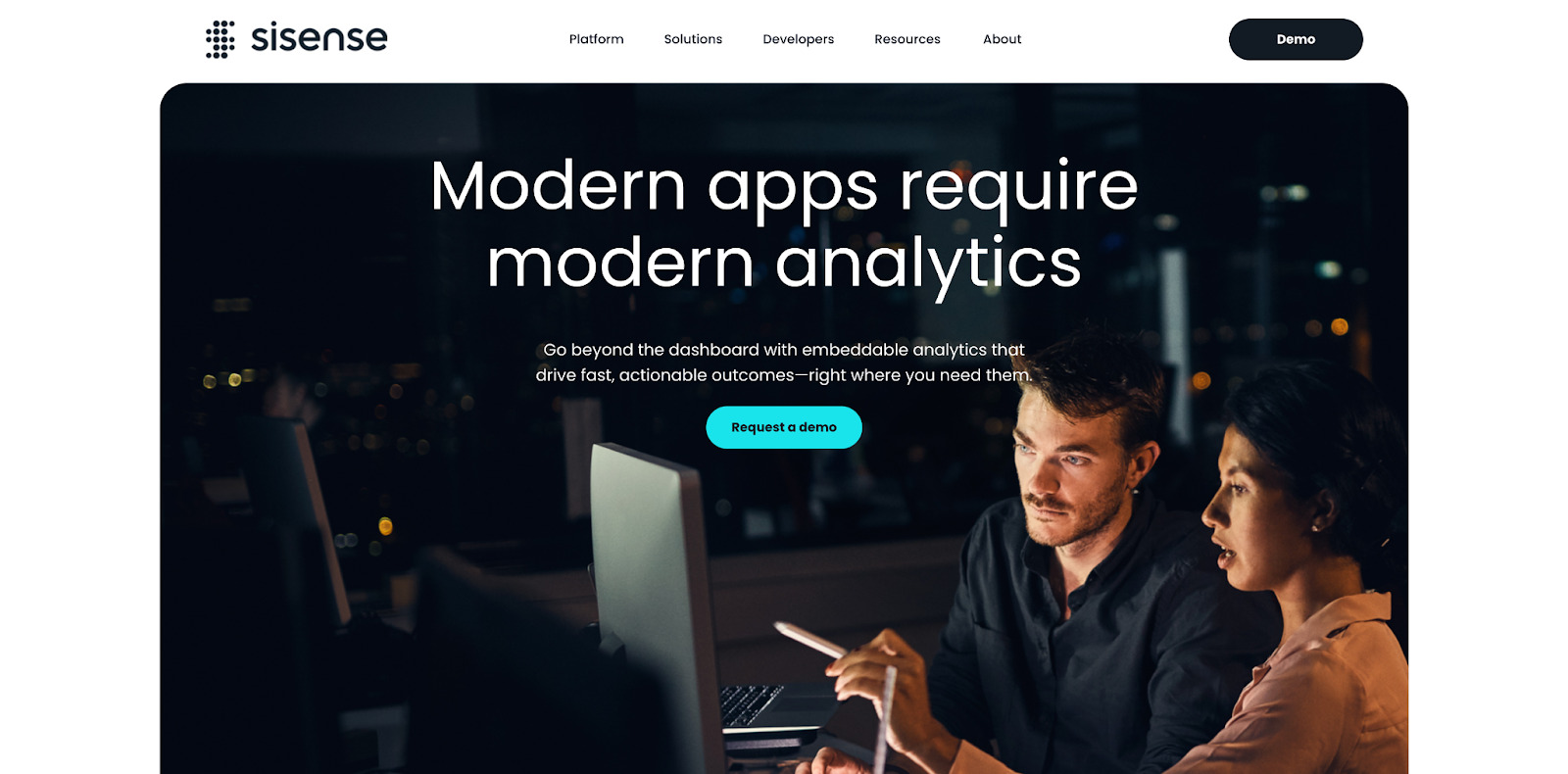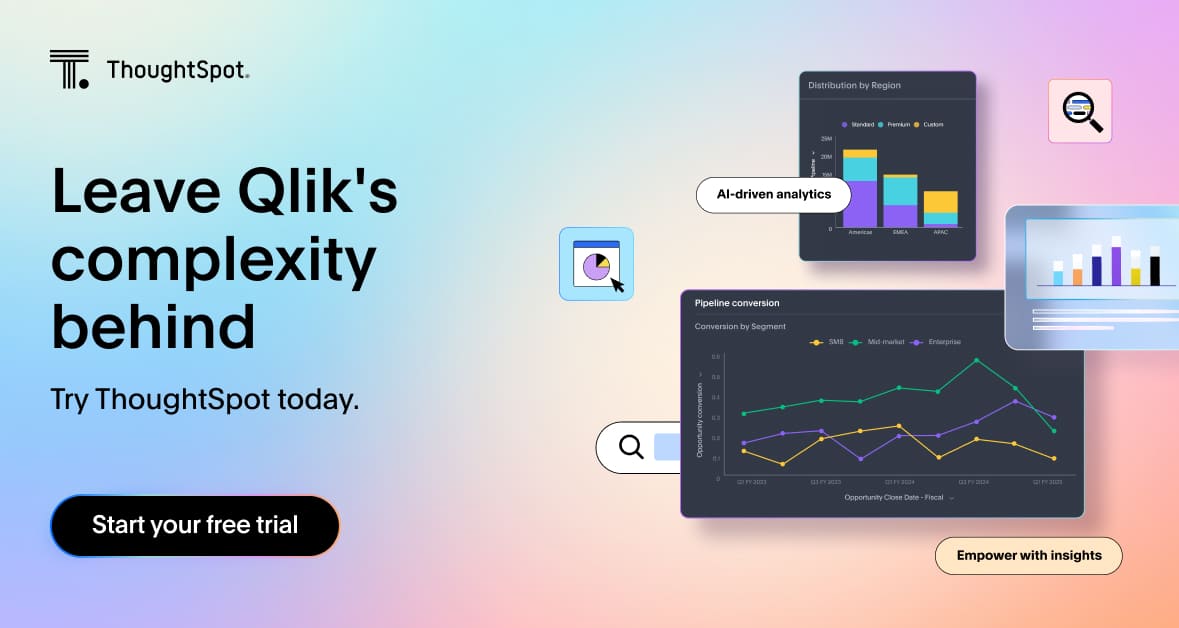The right business intelligence (BI) tool should make data easier to explore, analyze, and act on— not add extra complexity. While Qlik has long been a platform for interactive data discovery, it’s not the perfect fit for every team. Whether you’re looking for a more intuitive interface, stronger AI capabilities, or a solution that scales with your needs, there are plenty of Qlik alternatives to consider.
In this guide, we’ll break down the top Qlik competitors and highlight what makes each one stand out so you can find the BI platform that works best for you.
What is Qlik?
Qlik is a BI and analytics platform built for self-service data exploration. Its big selling point is the associative data model, which gives you more flexibility when connecting datasets. Unlike traditional SQL-based tools, you’re not locked into rigid, predefined queries.
If your team needs deep, interactive data discovery, Qlik can be a solid choice. However some users find it tricky to use, expensive, or lacking in customization options.
Where does Qlik fall short?
According to user feedback on G2 and based on our experience, here are some common challenges with Qlik:
Steep learning curve – Mastering Qlik’s scripting and associative model can be challenging for non-technical users.
Performance issues with large datasets – If you’re working with massive datasets, Qlik can struggle with performance, making analysis frustrating.
Complicated pricing – Costs can scale quickly, making it less budget-friendly for small and mid-sized businesses.
Limited AI capabilities – Qlik’s AI features are not as advanced as some modern BI tools like ThoughtSpot or Tableau.
UI and visualization limitations – Compared to competitors, Qlik’s interface and dashboard customization options feel less intuitive.
If any of this sounds familiar, it might be time to look at other BI tools that fit your needs better.
Top 5 Qlik alternatives to consider in 2025
Here’s a quick look at the top alternatives to Qlik, based on performance, pricing, and usability:
- ThoughtSpot — Best for AI-powered search and intuitive self-service analytics
- Tableau — Best for advanced data visualization and interactive reporting
- Power BI — Best for Microsoft integration and affordability
- Looker — Best for Google ecosystem users and governed data modeling
- Sisense — Best for embedding analytics directly into business workflows
ThoughtSpot is a powerful analytics platform and a strong alternative to Qlik, offering AI-driven insights and real-time data exploration. With a 4.4 G2 rating, it stands out for its search-based interface and generative AI capabilities, making it easy to ask complex questions in natural language and get instant insights—no technical expertise required.
Unlike Qlik, which has a steep learning curve and can slow down with large datasets, ThoughtSpot’s AI-powered search lets you explore data freely without relying on analysts or IT teams. Its intuitive, self-service interface removes bottlenecks, so you can get the insights you need, when you need them.
To cater to different use cases, ThoughtSpot offers two core products:
ThoughtSpot Analytics: A self-service platform that lets anyone create and share personalized insights using AI and natural-language search.
ThoughtSpot Embedded: A developer-friendly solution that integrates AI-powered analytics into any web application or workflow.
Key features of ThoughtSpot
Generative AI with Spotter: Your built-in AI Analyst delivers instant insights. Ask any data question, drill down for deeper insights, and get real-time alerts without writing a single query.
AI-Augmented dashboards: Static reports are a thing of the past. ThoughtSpot’s intelligent dashboards update automatically, helping you track KPIs and find insights before you even ask for them.
Advanced data modeling: Take full control of your data. ThoughtSpot connects with 20+ cloud platforms and offers ThoughtSpot Modeling Language (TML) for scripting, automation, and governance.
Enterprise-wide connectivity: Effortlessly integrate ThoughtSpot with cloud platforms and business applications for a unified analytics experience without data silos.
AI-driven data prep: Automate data cleaning and preparation in Analyst Studio with AI-powered SQL, Python, and R tools so you can spend less time prepping data and more time discovering insights.
Companies across industries are using ThoughtSpot to turn data into action.
Northmill, a digital bank, leveraged ThoughtSpot’s AI-powered analytics to identify a segment of customers who were dropping off during the sign-up process. By refining their onboarding approach based on these insights, Northmill achieved an incredible 30% increase in conversions.
Pros of ThoughtSpot
AI-powered search makes data exploration effortless.
Self-service analytics reduces dependence on data teams.
Smooth cloud integrations provide a unified analytics experience.
Real-time updates keep decisions fast and data-driven.
Cons of ThoughtSpot
Some advanced features, like custom data modeling, may need extra training to maximize their value.
ThoughtSpot’s regular updates introduce new capabilities, which can take time to keep up with.
Pricing
14-day free trial
Essentials: $1250 /month (20 users)
Pro: Custom
Enterprise: Custom
Tableau is another Qlik competitor designed for interactive dashboards and deep customization. It gives you extensive control over visualizations, but it comes with a learning curve. Working with complex datasets often requires technical expertise.
If you need flexibility in presenting data, Tableau delivers. Just be ready to invest plenty of time in learning it.

Key features of Tableau:
Visualization: Build a variety of charts, including pie, bar, line, scatterplots, histograms, and treemaps.
Data blending: Merge data from multiple sources into a single project to compare datasets and extract insights.
Collaboration: Work on shared data projects using Tableau Server, Tableau Cloud, or Tableau Public.
Augmented analytics: Use AI and natural language queries to analyze data and generate contextual insights.
Pros of Tableau:
Handles large datasets and processes millions of rows efficiently.
Extensive online resources, including training materials and active user communities.
Cons of Tableau:
Limited parameter selection requires manual data updates.
Creating advanced datasets often requires SQL knowledge, though working with prepared data is easier.
Performance can slow down with large datasets, especially when visualizations are highly detailed.
Pricing
14-day free trial
Tableau Creator - $75.00/user/month
Tableau Explorer - $42.00/user/month
Tableau Viewer - $15.00/user/month
Power BI is Microsoft's primary BI tool for data visualization, reporting, and dashboard creation. Its drag-and-drop interface simplifies report building, though customization and scalability can be more limited than other platforms on this list.
If you're already using Microsoft products, Power BI fits in effortlessly. Keep in mind that complex reports may require stronger data skills.

Key features of Power BI
Data integration: Connect to multiple sources, including Excel, SQL Server, Azure, and third-party applications.
Customizable dashboards: Create interactive dashboards and reports with real-time updates to support faster decision-making.
Data modeling: Use Power Query and Power Pivot to structure data and develop sophisticated models.
Natural language queries: The Q&A feature lets you ask data-related questions in plain language for easier analysis.
Pros of Power BI
Works seamlessly with Microsoft tools, making it a strong choice for those already in the Microsoft ecosystem.
Offers a variety of visualization options to present data effectively.
Cons of Power BI
Customization for advanced visualizations may be more limited than some other BI tools.
Handling large datasets can slow performance, requiring extra tools for processing.
Full functionality relies on cloud services, which may be a concern for organizations with strict data privacy or compliance needs.
Pricing
30-day free trial
Free account
Power BI Pro - $10/user/month
Power BI Premium - $20/user/month
Power BI Embedded - Variable
Looker is considered a close Qlik competitor that, designed to help businesses explore, analyze, and visualize data in real time. Its key differentiator is LookML, a proprietary modeling language that standardizes data definitions, providing consistency across teams.
For organizations already invested in the Google ecosystem, Looker can be a natural fit. However, it comes with trade-offs, particularly in usability and flexibility.

Key features of Looker
Cloud-based: Access Looker from anywhere without installing software. Its cloud-based setup streamlines deployment while maintaining strict security and access controls.
Custom data applications: Create tailored data experiences using reusable components and modules.
Automated workflows: Schedule reports and set up alerts to track key business metrics in real time.
Third-party integrations: Extend functionality beyond data visualization with connections to tools like Salesforce and Confluence.
Pros of Looker
Build customized reports and dashboards for deeper analysis.
Automates data processing tasks like aggregation and segmentation, streamlining workflows.
Cons of Looker
Sharing reports may require extra steps, which can slow down collaboration.
Performance issues may occur when working with multiple visualizations.
Limited documentation can make onboarding and troubleshooting more challenging.
Pricing
30-day free trial
Looker's pricing structure is complex, with separate platform and user licensing costs. Platform pricing covers standard, enterprise, and embedded options, but lacks clarity on integration details and their costs.
User licensing offers three types—Developer, Standard, and Viewer—which complicates your choice. With fees ranging from $30 to $125 per user per month, costs can escalate quickly for larger organizations.
Sisense is a BI and analytics platform built for data exploration, visualization, and embedded analytics. Its natural language querying (NLQ) and low-code interface make it accessible to business users, reducing the need for deep technical expertise.
With options to store data in ElastiCube or connect to cloud warehouses, Sisense allows for flexible deployment and real-time analysis. While it simplifies reporting and dashboard creation, it may not offer the same level of advanced data modeling as some BI tools.

Key features of Sisense
Git integration: Track changes and manage custom analytics code with version control.
Low-code interface: Build dashboards, widgets, and reports with minimal technical expertise.
APIs and SDKs: Customize integrations and workflows to extend functionality.
Data connectivity: Connect to cloud data warehouses, on-prem databases, and third-party applications.
Pros of Sisense
AI-powered exploration and automated insights help surface trends faster.
Embedded analytics let you integrate dashboards directly into applications or websites.
Cons of Sisense
More technical expertise may be required for advanced analytics.
Performance may slow down when handling large datasets or complex queries.
Some features have a steep learning curve.
Pricing can be high, especially for small to mid-sized businesses.
Pricing
Free demo available
Platform pricing - Custom
Upgrade to AI-Powered BI with right Qlik competitor
Your BI tool shouldn’t slow you down. If Qlik’s complexity or performance limitations are getting in the way, it’s time to find a solution that works for you and your team.
ThoughtSpot gives you the speed and flexibility to explore data on your terms—no complex scripting, no long wait times. With AI-powered search and intuitive self-service analytics, you can get answers in seconds, not hours.
Take control of your data with AI-powered analytics—see it in action with a live demo!









